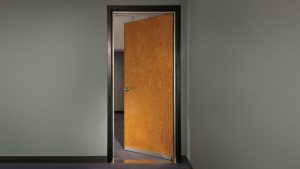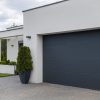How to soundproof your doors
Anyone who grew up in a shared room probably understands the value of a good door. Having the ability to close off from the outside world and sink into some solid solitary time is invaluable. Access to quiet time can seriously make or break your week. People with young children and those who work from home with the family know this all too well.
The problem with many interior doors is that they often underperform. The people who build modern houses tend to fit interior door frames with hollow core doors, which are a cheaper option, but they have very little mass or weight and allow more sound passage than most of us would find ideal.
Investing in a soundproof interior door or two will let you take back your meditative spaces and your sanity.
How to soundproof interior door effectively?
If you’ve lived in the same space for a long time, you may not pay that much attention to your doors. Maybe you think a door is a door and if it ain’t broke don’t fix it, which is an understandable assumption. To put it into perspective, think of someone who has never flown first class before. They might not understand the difference between a coach seat and a first-class seat. Once they’ve experienced the difference, it makes complete sense to them. This is just like the difference a soundproof interior door can make, a whole new world of possibilities may open up for you.
Adding soundproof doors may mean that the night owl watching classic movies late into the night can crank up the surround sound without guilt. It may mean you can take a nap, even when the kids are stuck in the house for a snow day. Maybe you just want the ability to have privacy during your afternoon conference calls in the den. Whatever reason you have for wanting silence, you will thank yourself for soundproofing your doors as it is a drastic difference.
Does this mean I need to replace all my doors?
The answer to this question is entirely up to you. While replacing all your doors with nice, solid core upgrades will certainly add resale value to your home, sometimes finances and living situations prohibit such an undertaking. If a full replacement is off the table, start by tackling the rooms you most want to be fitted with sound control measures. The best soundproof doors are those that provide moments of peace and quiet within your hectic day, so bedrooms, dens, and theater rooms are popular locations. You can add solid or soundproof doors to whichever rooms need them most and add more as life dictates.
Can I Soundproof Hollow Doors?
If you’d like to create a calming space without breaking the bank, there are some simple ways you can moderately soundproof hollow core doors rather than fitting a single or couple rooms with mismatched doors. Your options will look a little different, depending on the specific door you are soundproofing. There is no single best way to soundproof a door. In each case, the concepts will be the same, but the execution will vary.
If your door is capable of being taken apart and reassembled, you can add soundproof door panels to the hollow spaces on the inside of the door. Replacing the hollow spaces with dense, porous materials means a decent portion of the sounds coming from either side will be absorbed. Filling a door with sand also provides great sound control, but the door will become very heavy, and it requires enough disassembly of the door to pour the sand into the cavity. If your door won’t come apart without breaking, you still have options. If you plan on lining one or both sides of the door with something like mass loaded vinyl, you can use the vinyl sheets to cover any seams or cuts.
Soundproofing Around the Door
Once you’ve added some density to your door, it’s time to look at the spaces between the door and the frame. Depending on the height of the door frame, and whether or not you have carpeting, the gap below the door can leak a considerable amount of sound. If the door hangs high above hardwood floors, the gap might be larger, allowing for more sound to pass from one room to the next.
Consider adding a door sweep or acoustic door threshold to cover that space. Door sweeps are typically made of high-density metal and rubber and can be easily attached at the bottom of any interior door. They are also great at blocking sound and drafts. Acoustic door thresholds can work well if a door sweep is too noisy or must be set too high to accommodate thick carpeting, but are slightly more visibly obtrusive. Traditional door sweeps need to be mounted high enough that they clear any carpeting without causing friction and resistance, so keep that in mind if you choose to install them. Because of this, they don’t completely seal the gap, but they will usually cover a good deal of it.
Getting to the bottom of things
If you want to increase the insulation potential of your door sweep, our Automatic Door Bottoms retract the sponge neoprene gasket into the metal housing when the door opens, so the door easily clears the carpet of any height. When the door shuts, the sponge neoprene lowers so that it’s flush with the floor, giving the gap at the base of your door a complete seal. This is your best option for a soundproof under door area. They come standard in our Door Seal Kits, as well as all the parts you need to soundproof all sides of the door.
Our Door Seal Kits also contain adjustable jamb seals and door frame sound gaskets, which provide a complete seal when the door is closed. They mount to the inside of the door jamb with just a few screws, so you’ll save money by installing them yourself. They provide a lot of sound control with minimal visual impact and are an important part of soundproofing your interior doors.
How to soundproof interior door frames
With all doors, one of the problem places you’ll want to tackle is the air gap around the frame. If you aren’t experienced in the world of DIY home improvements, working on a door frame might seem intimidating at first. Not to worry though because once you pop the trim off of the frame, you’ll see that the installation is quite simple. You’ll also probably see an air gap that runs around the door frame. Since interior doors aren’t responsible for maintaining a seal from the outside elements, many builders ignore these air gaps, and simply cover them with trim.
The first rule of sound transmission is that if water or air can pass through a material, sound waves can pass through it as well. If you want to soundproof your doors effectively, the first step is eliminating air gaps. The simplest and the most cost-effective solution is to purchase a door seal kit. A Door Seal Kit features an automatic bottom seal and adjustable jamb seal. Together, an airtight seal is created and sound transmission is reduced tremendously.
Also, filling the air gaps with a gasket or high-density foam will prevent sounds from passing through those gaps.
Both work well, but filling the gaps with gaskets is a much cleaner solution that will make your work easier if you ever decide to replace the door frame in the future. When you use soundproof foam for door frames, the foam will fill the entire cavity, making upgrades messy. Treating these air gaps will also help prevent any drafts from entering the room, so it has some thermal advantages as well.
What if I need more?
Installing solid core doors and using the methods we’ve discussed to add soundproof properties to your existing doors will go a long way, but if you need some serious sound control, you’ve got some great options to choose from. Your best option is a professional grade soundproof door. Professional doors include all the pieces that come with creating superior soundproofing.
Choosing a Studio 3D Soundproof Door will create a bona fide sanctuary within your home. It includes all the soundproof jambs and seals you’ll need and boasts an STC (Sound Transmission Class) rating up to 56, which means even very loud speech can’t be heard through the door.
It’s the perfect solution for home offices, theater or music rooms, and studios. The Studio 3D Soundproof Door creates the perfect environments for quiet concentration and loud expression at the same time.
Decision Making Time
Above all, you want to make sure all your gaps are sealed, and you want to add some mass to your door. Whether this means installing a solid core door with insulating properties or retrofitting your existing door to fit your needs, creating a denser door is the best path to keeping your rooms private.
Even adding some fabric acoustical panels to the inside face of your door might keep reverberation down in the room, meaning there is less noise capable of escaping. There are budget hacks that do a little, and there are professional products that help a lot.
A soundproof interior door is only as good as the materials used. How valuable is silence to you?
















